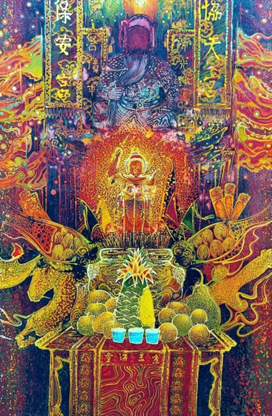“Object of Faith” in the Hiap Thian Keng Kuan Te Kun Shrine
Main Article Content
Abstract
This article aimed to study the creation of batik artistry in the series titled “Object of Faith” in the Hiap Thian Keng Kuan Te Kun Shrine by studying the objects of faith at the sacred site of the shrine in Sapam community, Phuket province. The creator did fieldwork to collect the data within the shrine, which is a centre for ceremonial activities, to create artistic works in the form of batik paintings and presented the work in an art exhibition format. The creative study showed that 1) the characteristics of objects of faith used in ceremonies at Hiap Thian Keng Kuan Te Kun Shrine expressed beliefs, reverence for various deities, and material culture symbols through worship resonating with the hearts of Thai-Chinese descendants; it reflecting their identity and memories of their Chinese ancestors vividly. 2) The creation of batik painting, through symbolic representations, showcased aesthetic beauty and the forms of objects of faith which conveyed symbolic meanings, interpreting various shapes, simplifying forms to express feelings in line with the principles of visual art elements, blending batik techniques, multi-layered wax line colouring, and wax splattering techniques throughout the creative process of batik painting.
Article Details

This work is licensed under a Creative Commons Attribution-NonCommercial-NoDerivatives 4.0 International License.
All authors must take public responsibility for the content of their paper. The WIPIT Journal Editors will not be taking any public responsibility for the content in the paper.
References
กนกพร ศรีญาณลักษณ์. (2553). การสื่อความหมายของภาพมงคลจีน. วารสารจีนศึกษา, 4(4), 22 - 43.
https://so01.tci-thaijo.org/index.php/CSJ/article/view/55093
กำจร สุนพงษ์ศรี. (2559). สุนทรียศาสตร์: หลักปรัชญาศิลปะ ทฤษฎีทัศนศิลป์ ศิลปวิจารณ์. จุฬาลงกรณ์มหาวิทยาลัย.
ถาวร สิกขโกศล. (2557). เทศกาลจีนและการเซ่นไหว้. มติชน.
เถกิง พัฒโนภาษ, แปลและขยายความจาก Brian Anthony Curtin. (2551). สัญศาสตร์ กับ ภาพแทนความ. วารสารวิชาการ คณะสถาปัตยกรรมศาสตร์ จุฬาลงกรณ์มหาวิทยาลัย, 1(1), 35–50. https://www.arch.chula.ac.th/journal/issue_detail.php?issue_id=3
ทวีเกียรติ ไชยยงยศ. (2538). สุนทรียะทางทัศนศิลป์ (พิมพ์ครั้งที่ 2). โครงการตําราคณะศิลปกรรมศาสตร์ สถาบันราชภัฏสวนดุสิต.
นันทา โรจนอุดมศาสตร์. (2536). การทำผ้าบาติก. โอเดียนสโตร์.
ปัทมาสน์ พิณนุกูล. (2563). กิมซิ้นกับม้าทรง: ความเป็นเทพกับความเป็นมนุษย์ในพื้นที่พิธีกรรมของคนจีนจังหวัดภูเก็ต [วิทยานิพนธ์ปริญญาดุษฎีบัณฑิต ไม่ได้ตีพิมพ์]. มหาวิทยาลัยมหาสารคาม.
พระครูศรีปัญญาวิกรม. (บุญเรือง ปญฺญาวชิโร/เจนทร). (2557). การศึกษาเชิงวิเคราะห์สัญลักษณ์ทางพระพุทธศาสนาในสังคมไทย [วิทยานิพนธ์พุทธศาสตรดุษฎีบัณฑิต, มหาวิทยาลัยมหาจุฬาลงกรณราชวิทยาลัย]. https://pubhtml5.com/lmgbw/zkpb/basic.
โรสนา รัฐการัณย์. (2555). การนำเทคนิคและลวดลายการวาดผ้าบาติกมาใช้ในการตกแต่งของใช้ในครัวเรือนเพื่อเพิ่มมูลค่าผลิตภัณฑ์ กรณีศึกษาจังหวัดปัตตานี. กรมส่งเสริมวัฒนธรรม.
ศักดิ์ชัย เกียรตินาคินทร์. (2553). @design: หลักการออกแบบศิลปะ. ไว้ลาย.
ศุภชัย สิงห์ยะบุศย์. (2564). สุนทรียศาสตร์. สาขาทัศนศิลป์ คณะศิลปกรรมศาสตร์ มหาวิทยาลัยมหาสารคาม.
สมชาย มนูจันทรัถ. (2551). ปรากฏการณ์ใหม่ของประเพณีกินผักในจังหวัดภูเก็ต: กรณีศีกษาศาลเจ้าจุ้ยตุ่ยเต้าโบ้เก้ง [วิทยานิพนธ์ปริญญาศิลปศาสตรมหาบัณฑิต ไม่ได้ตีพิมพ์]. มหาวิทยาลัยสุโขทัยธรรมธิราช.


